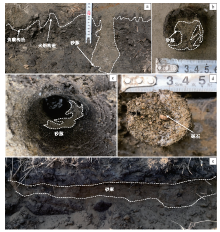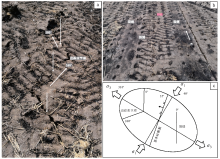第一作者简介 邵珠福,男,1984年生,毕业于中国石油大学(华东),现为东北石油大学地质系副教授,主要从事沉积学与石油地质学的教学和研究。E-mail: kangzhu09@yeah.net。
2018年 5月 28日,吉林松原市宁江区毛都站镇牙木吐村发生M 5.7级地震( 45°16'12″N, 124°42'35″E),震源深度13 km,震中位于郯庐断裂带西北侧的扶余 /松原—肇东断裂带、第二松花江断裂带和扶余北断裂带交汇处。地震诱发震中距3 km范围内普遍的液化和地表裂缝,给当地居民带来严重灾害。可见液化构造以砂火山为主,其次为液化砂堆、液化砂脉和液化砂席等。液化砂火山又可分为有火山口型砂火山、无火山口型砂火山和无砂型(水)火山。地震液化伴生软沉积物变形构造有变形层理、负载构造和火焰构造、滑塌褶皱、碟状构造和包卷层理等。地震诱发液化砂火山形成过程包括液化层内超孔隙流体压力形成、上覆低渗透层破裂和水、砂喷出地表后砂涌 3个阶段。液化和流化砂体在上涌过程中会注入低渗透黏土层形成各种形态的砂脉、砂席和多种类型的变形构造。垂向上地震液化结构可划分为底部松散可液化层、下部液化变形层、上部液化变形层和地表砂火山 4层结构。液化层埋深 2~5 m,液化层厚度2 m。松原M 5.7级地震发震机制为 NE- SW( 35°~215°)方向挤压应力使断层活跃,推测扶余 /松原—肇东断裂是主要的发震断层。松原地震液化构造研究为现代地震活动区和灾害易发区预测提供依据,为地震引发的现代软沉积物变形构造研究提供丰富的素材,兼具将今论古意义,为揭示本世纪以来郯庐断裂带北段进入了一个强断裂和地震活跃阶段提供了最新的实际资料。
About the first author Shao Zhu-Fu,born in 1984,is an associate professor of the Department of Geology of Northeast Petroleum University,with a Ph.D. degree obtained from China University of Petroleum. He is currently engaged in sedimentology and petroleum geology. E-mail: kangzhu09@yeah.net.
An earthquake of magnitude M5.7 occurred in Yamutu village,Songyuan City,Jilin Province of Northeast China(45°16'12″N,124°42'35″E)on May 28,2018,with a focal depth of 13 km. The epicenter is located at the intersection of the Fuyu/Songyuan-Zhaodong fault,Second Songhua River fault and Fuyu north fault which lie west of Tanlu Fault. The earthquake-induced widespread liquefication structures and ground cracks within 3 km from the epicenter,bringing serious disasters to the local surroundings. The visible liquefied structures are mainly composed of sand volcanos,followed by liquefied sand mounds,sand dikes and sand sills. The liquefied sand volcanoes can be divided into volcanoes with craters,volcanoes without craters and water volcanoes(sand-free). Other soft-sediment deformation structures(SSDSs)induced by earthquakes include deformation lamination,load structures and flame structures,deformation folds,dish structures,convolute bedding and some water-escape structures. The formation process of the sand volcanos comprises building up excess pore-fluid pressure in the liquefied layer,cracking of the low-permeability overlying layer and sand-water venting out of the ground surface inthree stages. During the upwelling,the liquefied sand is injected into the low-permeability layer to form sand veins,sand sills and various types of deformation structures. The vertical seismic liquefaction structure can be divided into the four parts of the bottom clean unconsolidated liquefiable sand,the lower liquefied deformation layer,the upper liquefied deformation layer and the ground surface liquefied sand volcano layer. The liquefaction occurred at a buried depth of 2-5 m,causing a thickness of 2 m of sand to liquefy. NE-SW(35°~215°)trending compressive stress that caused the fault to reactivate may be the seismogenic mechanism of the Songyuan M5.7 earthquake,and the Fuyu/Songyuan-Zhaodong fault was conjectured to be the major seismogenic fault. The study of the Songyuan seismic liquefaction structures provides guidance for the prediction of modern earthquake activity areas and disaster-prone areas and provides abundant basis material for studying earthquakes induced SSDSs in modern sediments,which will be of great significance in interpreting the theories of “the present is the key to the past”,which provides the latest practical data to reveal that the northern part of tanlu fault zone has entered into a stage of strong faults and seismicity since the beginning of this century.
软沉积物变形构造的形成取决于沉积物(未固结)液化敏感性、改变沉积物屈服强度状态的触发机制和足够的驱动力3个方面(Allen, 1986)。
变形机理随材料性质的不同而不同, 对于弹塑性地质沉积物, 足够大的应力超过其屈服强度或降低其固有屈服强度均可导致变形(Owen, 1987)。
液化变形是一种常见的无黏性软沉积物变形构造, 如液化砂脉、液化砂席、液化砂柱、液化砂(泥)火山、液化砂管、液化砂涌(sand blow)、液化砂尖顶(cusps)、包卷层理、碟状构造、负载构造、回缩构造、底辟构造、假结核和其他泄水构造等(Lowe, 1975, 1976; Allen, 1977, 1982; Owen, 1987, 1995; Obermeier, 1996; Takahama et al., 2000; Rodrí guez-Pascua et al., 2000; Tuttle, 2001; Massari et al., 2001; Kholodov, 2002; Lu et al., 2006; Moretti and Sabato, 2007; Glennie and Hurst, 2007; Chen et al., 2009; Bonini, 2009; Owen et al., 2011; Owen and Moretti, 2011; Ross et al., 2011; Gibert et al., 2011; Rowe, 2013; Su et al., 2014; Valente et al., 2014; 易雪斐等, 2015; Oppo and Capozzi, 2016; Ulvrova et al., 2016; Mazumder et al., 2016; 杜远生和余文超, 2017; Hurst and Vigorito, 2017; 钟建华等, 2018)。液化甚至可产生大型砂岩注入体(Satur and Hurst, 2007; Grippa et al., 2019)。
液化可分为静态液化、脉冲液化和循环液化3种类型(Owen, 1987), 可发生在冰川、荒漠、山间凹陷、河流、三角洲、潮汐带、滨浅海、大陆斜坡和海底扇等多种环境(Kuribayashi and Tatsuoka, 1975; Alfaro et al., 1997; Moretti et al., 2001; Moretti and Sabato, 2007; Shi et al., 2007; Perucca et al., 2009; Wagoner Loon, 2009; Alfaro et al., 2010; Wagoner Loon and Maulik, 2011; Moretti and Ronchi, 2011; Phillips et al., 2013; Owen and Santos, 2014; Ravier et al., 2015; 钟建华等, 2018; Koç -Taş gı n and Diniz-Akarca; 2018), 甚至可以发生在火星上(Mahaney et al., 2004; Wang et al., 2005), 但以湖泊和海洋为主。液化多发生在碎屑岩和碳酸盐岩中(Su et al., 2014)。地震、火山喷发、海啸和风暴水波、沉积物负载、冰川消融、冻土融化、成岩作用、潮汐、洪水、滑动滑塌、浊流、地下水活动、管道流、气体泄漏、底辟作用、海平面升降和生物活动等都可以触发液化活动(Burne, 1970; Allen and Banks, 1972; Owen, 1987; Obermeier, 1996; Murton et al., 2000; Harris et al., 2000; Moretti et al., 2001; Mahaney et al., 2004; Zhong et al., 2006; Mazumder et al., 2006; Glennie and Hurst, 2007; Greb and Archer, 2007; 钟建华等, 2008; Owen and Moretti, 2008, 2011; 梅冥相等, 2009; 钟建华和梁刚, 2009; Wagoner Loon, 2009; Alfaro et al., 2010; Owen et al., 2011; Rowe, 2013; Li et al., 2013; Chen and Lee, 2013; Miyakawa et al., 2013; Phillips et al., 2013; Tian et al., 2013; 邵珠福等, 2014a; Owen and Santos, 2014; Ravier et al., 2015; Ulvrova et al., 2016; Mazumder et al., 2016; Ko et al., 2017; Hurst and Vigorito, 2017; Capaccioni et al., 2017; 杜远生和余文超, 2017; 冯增昭等, 2017; 冯增昭, 2017; 钟建华等, 2018; Koç -Taş gı n and Diniz-Akarca, 2018)。
地震常常引起饱和砂沉积层液化和流化, 地震时, 饱含水的松散沉积物受到地震循环波剪切力影响, 静态孔隙水形成了具超孔隙水压力的水体, 并克服了砂颗粒间的内摩擦力而使砂颗粒发生流动, 颗粒重新排列。饱和砂沉积物变为无流体, 没有屈服强度, 上覆压力和颗粒之间支撑力转化为颗粒之间的孔隙流体压力, 此时液化产生并持续一段时间。随后颗粒恢复至接触状态, 排列更加紧密(Allen, 1982; Owen, 1987; Obermeier, 1996; Obermeier and Pond, 1999; Tuttle, 2001; Owen and Moretti, 2011)。随着地震周期性震荡, 剪切力持续增加, 孔隙流体压力逐步增强, 当孔隙流体压力(pore-fluid pressure)超过上覆地层压力或者上覆密封层的破裂压力时, 孔隙流体压力释放, 产生流化, 导致应变, 流体携带砂体流动, 于是产生泄水构造和变形(Obermeier, 1996; Owen et al., 2011; 邵珠福等, 2014a, 2014b, 2014c)。地震液化强度与震级、震中距、震源深度和地震持续时间有关, 同时受沉积物颗粒大小、厚度、固结程度、上覆非渗透层厚度等条件影响(Burne, 1970; Obermeier, 1996; Moretti et al., 1999; Valente et al., 2014)。液化在粗粉砂和细砂中最易发生(Owen and Moretti, 2011), 也有学者发现了砾石液化(Takahama et al., 2000)。一般引起液化最小震级M5~6级(杨承先, 1985; Allen, 1986; Obermeier and Pond, 1999; Ko et al., 2017)。
2018年5月28日1时52分, 松原市宁江区发生M5.7级地震(45° 16'12″N, 124° 42'35″E), 震源深度13 km, 随后28— 31日发生多次2~3级余震。地震引发周围3 km范围内广泛发育液化和流化构造, 其中以液化砂火山最为普遍。文中通过详细介绍液化构造种类、组合关系与空间分布等, 阐述其成因机制, 以期对古地震和现代地震研究提供素材。
松原地处吉林省西北部, 地貌上属于平原区, 构造位置位于郯庐断裂带北段西侧、松辽盆地中央凹陷带(图 1)。松辽盆地为华北板块、西伯利亚板块和太平洋板块所夹持的前中生界基底上的中、新生代陆相叠合盆地(葛荣峰等, 2015; 孟元林等, 2012; 王璞珺等, 2015; 韩江涛等, 2018), 西侧为嫩江— 开鲁断裂和大兴安岭, 东侧为郯庐断裂带北段的依兰— 伊通断裂带和张广才岭, 北侧为讷谟尔河断裂带和小兴安岭, 南侧为赤峰— 开原断裂和燕山构造带, 主体呈NNE方向, 盆地发育经历了断陷— 坳陷— 反转三大演化阶段, 充填碎屑岩与火山岩沉积, 盆地内部断裂以NNE-NE和NNW-NW向为主(张功成等, 1997; 何委徽等, 2011)。
 | 图 1 中国吉林松原地区构造位置图 F1— 嫩江— 开鲁断裂带; F2— 依兰— 伊通断裂带; F3— 赤峰— 开原断裂 红色圆点为1976年以来松辽盆地及周边地震震中位置, 黄色圆点为2018年5月28日松原宁江区牙木吐村M5.7级地震发育位置Fig.1 Tectonic location of Songyuan area in Jilin Province, China |
郯庐断裂带是中国东部中新生代以来长期活动的深大断裂, 长约2400 km, 其北段(肇兴— 昌图段)从松原地区东侧穿过, 北起黑龙江边的肇兴县, 南到昌图县, 走向NE40° ~45° , 延伸约 800 km, 分依兰— 伊通和密山— 敦化2条主干断裂(罗志立等, 2005; 万桂梅等, 2009)。郯庐断裂带中— 新生代断裂和地震活动十分频繁和强烈, 如在1668年在郯城— 莒县发生了华北地区最强烈的8.5级的大地震, 在其中段的沂沭断裂带及其附近地区的中— 新生代地层中, 已识别出由地震产生的软沉积变形构造(震积岩)的组级地震事件地层多达17个(田洪水等, 2017)。
松原地区周边断裂活动频繁(图 2), 最主要的有扶余— 肇东断裂、第二松花江断裂、扶余北断裂、孤店断裂、查干花— 道字井断裂(杨清福等, 2010; 薛艳等, 2015; 邵博等, 2015; 刘权锋等, 2017; 刘俊清等, 2017; 盘晓东等, 2018)。
 | 图 2 中国吉林松原地区及周边断层分布(据刘权锋等, 2017; 修改)Fig.2 Fault distribution of Songyuan area and its surrounding areas in Jilin Province, China(modified after Liu et al., 2017) |
1)扶余— 肇东断裂。北起肇东, 南到怀德, 为松辽盆地中央凹陷区和东南隆起区分界线, 走向NE, 倾向SE, 倾角70° ~80° , 为早、中更新世活跃断层(刘权锋等, 2017; 盘晓东等, 2018)。
2)第二松花江断裂。西起大安, 东到崇善, 全长超过500 km, 走向NW, 倾向SE, 倾角70° ~80° , 最新活动时代早、中更新世(杨清福等, 2010)。
3)扶余北断裂。扶余— 肇东断裂分支, 走向EW, 倾向S, 倾角70° ~80° , 为一长度近30 km的隐伏断裂, 全新世以来一直活跃(刘权锋等, 2017)。
4)孤店断裂。扶余— 肇东断裂分支, 走向NE-NW, 倾向SE, 长度超过60 km, 具有典型的正反转构造性质, 全新世以来仍有活动(邵博等, 2015; 刘权锋等, 2017)。
5)查干花— 道字井断裂。扶余— 肇东断裂南段分支, 走向NE-NW, 倾向NW, 长度超过30 km, 全新世以来仍有活动(刘权锋等, 2017)。
松原地处松嫩平原腹地, 第四纪松散沉积物厚度80~100 m, 主要为黑色淤泥与砂土质互层沉积, 地层从下到上依次为下全新统温泉河组、中全新统坦途组和上全新统郭家店组(郭伟静等, 2007; 赵福岳, 2010)。地下水位埋深一般小于5 m(田辉等, 2011; 盘晓东等, 2018)。据震中约1 km处3口浅钻井显示(图 3), 牙木吐村周边浅地表松散沉积物(郭家店组)可划分5个地层单元: ①为富含腐殖质黏土(黑土地), 厚度50~70 cm, 为农作物生长主力层位; ②浅棕色粉砂质黏土, 与地层单元①呈渐变关系, 粒度略粗, 厚度45~60 cm; ③红褐色黏土, 为古风化壳沉积, 可作为标志层全区对比, 厚度10~15 cm; ④浅灰色粉砂质黏土, 厚度10~15 cm, 粒度较单元③变粗, 含水饱和度增高, 与下覆单元呈渐变过渡关系; ⑤浅黄色细砂、粉砂, 分选、磨圆较好, 饱含水, 厚度约20 m。
 | 图 3 中国吉林松原M5.7级地震震源区浅层沉积物岩性剖面图Fig.3 Lithologic profile of shallow sediments in sesmic region of the M5.7 earthquake in Songyuan area, Jilin Province, China |
自2006年以来, 松原地区地震频发, M2级以上地震多达77次, 2013年以后地震活动尤为频繁, 且多以浅源地震为主(图 4)。
 | 图 4 中国吉林松原地区2000年以来地震(M≥ 2)发育分布(数据截止到2019年6月3日)Fig.4 Tempotal distribution of earthquakes(M≥ 2)after 2000 in Songyuan area, Jilin Province, China (based on data before June 3rd, 2019) |
有史记载最大1次地震为1119年发生在前郭县的6
由于郯庐断裂带与其附近的断裂存在着主从与联动的活动关系(王小凤等, 2000), 因此, 处在郯庐断裂带北段近旁的扶余— 肇东及孤店等活断层与依兰— 伊通主干断裂带的活动也存在着上述主从与联动关系。
松原地区2018年5月28日M5.7级地震导致地表松散沉积物(图 3中地层单元⑤)严重的液化现象, 在应力薄弱带形成液化喷砂流(砂火山喷发)。地震瞬间或者地震后不久(数分钟内), 液化层内强烈的超孔隙压力突破上覆地层重力或破裂压力, 沿早期的洞穴或者裂缝发生泥砂上涌, 形似喷泉, 砂火山喷发持续时间可达半小时, 当压力足够大, 液化泥砂喷流高度可达6~7 m(Obermeier, 1996)。砂火山喷流结束后, 喷出的泥砂在火山口堆积, 形成各种类型的砂火山, 如图 5所示, 地震结束后, 在震中距3 km范围内发现了多处液化砂火山。根据前述, 地层单元⑤为砂火山的液化源层, 上覆于第⑤层之上的①— ④层为非液化层(属非透水层), 层内发育液化侵入砂脉或砂席。
 | 图 5 中国吉林松原M5.7级地震液化砂火山分布 黄色符号标注的点为砂火山分布的位置Fig.5 Distribution of liquefied sand volcanoes of the M5.7 earthquake in Songyuan area, Jilin Province, China |
液化砂火山又称sand boil(Lowe, 1975; Obermeier et al., 1990, 1992; Obermeier, 1996; Li et al., 1996; Moretti et al., 1999; Tuttle, 2001; Massari et al., 2001; Kanibir et al., 2006; Ross et al., 2011; Moretti and Ronchi, 2011; Bhattacharya et al., 2011; Yamaguchi et al., 2012; Capaccioni et al., 2017), 是松原松原地区最普遍的地震触发构造, 也是最主要的液化构造类型。在松原M5.7级震源区周围3 km范围内发现液化砂火山出露点超过55个, 液化砂火山分布具有成群性, 且展布具有一定的优势方向(图 5)。根据形态和结构, 液化砂火山可分为3种类型。
3.1.1 有火山口型砂火山
地震产生液化和流化后, 超孔隙流体压力流体携带液化层砂体上涌, 沿着断裂带或者应力薄弱带形成通道(水腔)(Lowe and Robert, 1974; Lowe, 1983; Owen, 1996; Harris et al., 2000; Massari et al., 2001; Owen, 2003; Wagoner Loon, 2009; Yamaguchi, 2012; Phillips et al., 2013; Su et al., 2014), 喷出地表后, 形成砂火山(图 4)。随着能量减弱, 喷发停止, 形成火山口状沉陷(Collinson et al., 2006)、回填构造(Takahama et al., 2000)和砂涌(Obermeier, 1996; Tuttle, 2001; Owen and Moretti, 2011)。流体压力释放后, 两翼砂体因脱水形成朵叶体沉积, 平面上呈圆形, 宽度不等, 剖面上一般呈圆锥形或者穹窿状, 内部发育倾斜层理(Collinson et al., 2006)。
砂火山的规模与震级和距离震中远近有直接关系, 一般来讲, 地震等级越大、震中距越小, 砂火山越大, 2013年松原M5.8级地震诱发单个液化喷砂面积超过300 m2(魏美璇等, 2016)。如图 6所示, 松原M5.7级地震在距离震中800 m处可见最大砂火山沉积直径超过12 m(图 6-a), 随着震中距增加, 砂火山规模减小, 最小者直径仅5 cm, 一般砂火山直径2~8 m, 砂火山口直径0.5~1 m。砂火山沉积厚度在火山口周围大, 向外逐渐变小, 厚者可超过0.5 m, 薄者仅为2 cm。砂火山的分布可分对称型和非对称型, 一般来讲, 地表地形平坦、无障碍物阻挡并且砂体分布范围大者分布均匀(图 6-b), 地势高地起伏、受地表断裂影响和障碍物阻挡处, 砂火山不对称(图 6-c, 6-d)。同时砂火山对称形态可能受风向等因素影响。砂火山的分布有孤立的(图 6-a, 6-d), 也有成群分布(图 6-b, 6-c), 成群分布的砂火山一般具有优势排列方向, 研究区成群砂火山分布优势方向为N-S方向(图 5), 其次为NW-SE方向。
随着周期性地震波影响, 砂火山喷发也具有周期性特点。当喷发结束后, 砂体侧向流动可形成倾斜层理, 如图 7所示, 倾斜层理形态与砂火山沉积基本保持一致, 从火山口侧缘向四周尖灭, 在靠近火山口内部, 由于喷发回流作用, 层理多向砂火山通道内部延伸, 流体携带泥砂, 充填火山口, 形成回填构造(Takahama et al., 2000), 在此过程中在火山口沉积边缘形成冲沟, 两侧朵叶体沉积表面发育小型表面水系(图 6-b)。松原砂火山沉积倾斜层理单层厚度0.5~5 cm(图 8-a至8-c), 局部微层序可见层理显正粒序特征(图 7; 图 8-b), 代表孔隙流体压力逐渐减小的单次喷发过程(Rodrí guez-Pascua et al., 2015), 喷发开始时, 能量较强, 沉积物颗粒较粗, 随后能量减弱, 颗粒变细。在垂向剖面中, 砂火山沉积透镜体经常会被误认为沉积层, 倾斜层会被误认为是交错层理(Collinson, 2006)。
 | 图 7 砂火山沉积内部结构示意图(据Obermeier, 1996; Su et al., 2014; 修改)Fig.7 Sketch showing internal structure of sand volcanoes(modified after Obermeier, 1996; Su et al., 2014) |
地震液化, 超孔隙流体压力流体携带砂层向上逃逸, 侵蚀两壁低渗透黏土, 形成泥质角砾, 泥质角砾随砂体一起上涌、喷出并沉积(Obermeier, 1996; Su et al., 2014), 松散黏土颗粒经过一定距离的搬运厚具有较好的分选性和磨圆性, 且沉积后呈叠瓦状排列(图 7; 图 8-d), 也有学者指出砂火山沉积中无泥质角砾沉积(Li et al., 1996)。
3.1.2 无火山口型砂火山
无火山口型砂火山是丘状或坟堆状砂体沉积, 无明显火山口沉降带, 砂火山沉积中间最高, 向四周变低, 平面上近圆形或椭圆形, 剖面呈透镜状或者圆锥状, 孤立或者呈条带状分布。砂火山直径0.2~10 m, 高0.1~0.6 m。如图 6-d所示孤立无火山口型砂火山沉积, 平面呈椭圆状, 长轴方向近N-S。
根据无火山口型砂火山的上述特征且与具有火山口的砂火山对比, 推断无火山口型砂火山形成满足2个条件: 一是有足够的液化砂体供应, 使得具超孔隙流体压力的液化砂喷出地表后, 其涌道能及时充填; 二是超孔隙水压力不足, 涌道空间刚被充填, 超孔隙水压力就被消耗已尽而不足以使液化砂继续喷出, 从而形成了无火山口型砂火山堆积。
3.1.3 无砂型(水)火山
无砂型(水)火山是指砂火山喷发时只喷出水, 无砂体喷出和堆积, 只存在一个火山口。如图 9所示无砂型火山口近圆形, 直径2.2 m, 火山口沉降45 cm。火山口边缘发育同心环形正断层, 火山口内部发育多组不同方向断裂。
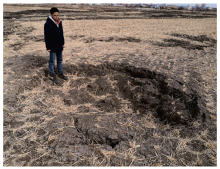 | 图 9 中国吉林松原地震无砂型火山口 照片拍摄位置为图 5中点CFig.9 Crater of water volcanoes(sand-free)of the M5.7 earthquake in Songyuan area, Jilin Province, China |
无砂型(水)火山口沉积还没有学者报道, 在研究区只发现1处, 形成此种类型火山口需要特殊的地质和水动力条件: 首先, 液化区砂体供应缺乏或者无砂体沉积, 使得流体上涌时并未携带砂体; 其次, 超孔隙流体压力值在适当范围, 不宜过大, 流体上涌突破地表时迅速减小至零, 因此难以携带砂体喷出。有学者指出该类凹坑属于“ 震塌陷” 、“ 震陷坑” 、“ 震陷向斜” (陈希哲, 2003; 田洪水等, 2015)。岩浆喷发火山口和砂火山口的形成在某种意义上都有塌陷成因, 此类型火山沉积的动力学过程还需要进一步细致研究。
地震诱发砂火山的形成主要包括地震前、地震时和地震后3个阶段(Rodrí guez-Pascua et al., 2015)。地震前阶段, 饱含水的松散沉积物以细砂为主, 分选和磨圆较好, 上部被低渗透性黏土层或粉砂质黏土层覆盖, 覆盖层的厚度不宜过大, 才能满足形成砂火山形成的物质条件(图 10-a)。地震时, 受地震波剪切力影响, 地面震动产生裂缝, 松散砂层液化, 孔隙水向上运动, 聚集在黏土层和砂层分界处(图 10-b)。单次液化结束后, 砂再次沉积, 排列更加紧密, 超孔隙流体压力持续聚集于砂层和黏土层分界面, 孔隙流体压力不断增加, 产生上举浮力; 上覆黏土层因持续震动而上下波动, 裂缝进一步扩大(图 10-c)。地震结束后, 当孔隙流体压力逐步升高并超过上覆黏土层水力破裂压力时, 产生水力压裂断层, 高能水体喷射出地表形成火山(图 10-d), 随后引起更广泛的砂体液化和流化, 水的上移携带砂体持续喷出地表形成砂火山, 水和砂喷射引起火山口两侧地面上下波动(图 10-e)。持续的地面波动使地表沉降区和隆升区相间, 因此产生更多断裂使砂和水继续喷出形成砂火山(图 10-f)。当地震能量全部释放, 超孔隙流体压力减小至静压平衡, 砂火山喷发结束, 液化和流化停止, 喷出地表流动的砂因脱水停止运动形成砂火山沉积, 砂火山过程结束(图 10-g)。
 | 图 10 地震诱发砂火山形成过程示意图(据Rodrí guez-Pascua et al., 2015; 修改)Fig.10 Sketch showing forming process of sand volcano induced by earthquakes(modified after Rodrí guez-Pascua et al., 2015) |
松原M5.7级地震诱发了广泛的砂堆构造(图 11), 砂堆构造形成于2种环境, 一种是距离地面约2 m高的沙丘上, 沙丘以古河道边滩沉积细砂和粉砂为主, 其次为风成砂(图 11-a); 另外一种砂堆发育于砂火山沉积体上, 火山口内部和侧翼朵叶体都有砂堆存在(图 11-b, 11-c)。砂堆形态类似于火山锥, 没有或者有很小的火山口, 平面呈圆形, 剖面呈透镜状, 直径3~15 cm, 砂堆高度3~8 cm。砂堆大多成群发育, 砂堆沉积周围颗粒较粗, 向中间锥顶颗粒逐渐变细, 砂堆内部见小型倾斜层理, 倾角30° 左右。
砂堆构造是一种特殊的砂火山构造(Su et al., 2014)。砂堆是由地震液化诱发, 但其形成需要特殊的地质条件。首先, 砂堆形成于砂体之上而非黏土之上, 且砂体分选和磨圆较好, 易于液化或者本身就是液化体; 其次, 地震液化形成超孔隙流体压力要在适度范围, 不宜过小, 否则难以喷发, 也不宜过大, 否则形成大型砂火山; 再者, 砂堆形成时砂体处于欠饱和状态, 砂子喷出成为砂体后不能流动或者只能短距离运移, 砂子多靠重力近源堆积, 因此砂堆沉积最前端(裙边)沉积颗粒较粗, 这不同于常规砂火山沉积。地震液化导致流体携带流化砂体上涌, 冲出地表黏土时继续向上运移, 能量迅速衰减, 喷出沙丘顶面形成第1种砂堆(图 11-a), 当超压水和砂冲破封盖层喷出地表形成砂火山后, 在其内部仍存在超孔隙压力, 因此流体携带砂喷出砂火山沉积形成第2种砂堆, 因能量衰减, 所以砂堆规模较小, 几乎没有火山口(图 11-b, 11-c)。
液化砂脉和砂席规模受震级和震中距控制, 松原M5.7级地震液化砂脉宽度3~11 cm, 侧向延伸长度0.2~2 m, 砂席厚度5~15 cm, 侧向延伸超过50 m(图 12)。一般液化砂层厚度大、上覆非液化软沉积层的厚度适中、地下水位线高是形成砂脉和砂席的有利条件。液化砂脉和砂席是最常见的地震诱发液化变形构造之一(Obermeier et al., 1990; Obermeier and Pond, 1999; Obermeier and Dickenson, 2000; Rodrí guez-Pascua et al., 2000; Tuttle, 2001; Shi et al., 2007; Perucca et al., 2009; Wagoner Loon, 2009; Berra and Felletti, 2011; Topal and Ö zkul, 2014; Hilbert-Wolf et al., 2016; Ko et al., 2017; Brogi et al., 2018; 钟建华等, 2018)。近几年, 在郯庐断裂带中段的中— 新生界中已识别出了多个发育液化砂脉等的地震事件地层(田洪水等, 2005, 2016, 2017; Tian et al., 2015, 2016; 张邦花等, 2016)。
砂脉和砂席的形成机理有3种, 分别是水力压裂、侧向传播和表面震动(Obermeier and Pond, 1999)。当液化强度更大时, 砂脉和砂席演变为大型砂岩侵入体, 厚度可达数十米, 延伸范围几千平方千米(Obermeier et al., 1991; Satur and Hurst, 2007; 钟建华等, 2018; Grippa et al., 2019)。
地震液化后, 除了发育砂火山外, 液化砂层会侵入上覆低渗透黏土层中, 砂火山通道和砂与黏土分界面是最有利的场所, 其次是黏土层内部各岩性分界面(图 3)。砂脉的方向和形态无确定性, 云朵状、飘带状、蘑菇状、柱状等皆有可能。砂席一般为水平或顺层发育的砂脉, 其规模一般大于正常砂脉。
与砂火山和砂脉等地震震动液化变形构造共(伴)生其他软沉积物变形构造主要有负载构造、火焰构造和变形层理(图 8-a, 8-c, 8-d; 图 12-a)。在不同的强地震区, 这些变形构造是最为常见, 如许多学者(Alfaro et al., 1997, 2010; Owen et al., 2011; Tian et al., 2013; Topal and Ö zkul, 2014)识别出的负载构造; Pisarska-Jamro
结合区域地质特点, 总结松原M5.7级地震三维液化构造沉积模式(图 13)。垂向上, 松原M5.7级地震液化构造具有明显分层性: ①最底层地震液化层:厚度大、分选和磨圆较好的未固结细砂及易受地震剪切力影响而液化。地下水位线也位于该层, 液化构造形成的前提是高渗透松散砂体饱含水, 水位线不宜过低, 否则难以液化, 一般2~5m。变形层理、包卷层理、泄水构造等常在该层发育。②下部液化构造带:位于上覆低渗透黏土下端, 距离砂层较近, 为第1层液化构造带。受地震液化和流化作用影响, 高孔隙压力流体和砂上涌, 穿过岩性分界面, 侵入上覆黏土中形成砂脉、砂席, 伴生变形层理、负载构造等。③上部液化构造带:液化上涌流体携带砂及部分泥屑运移至近地表时, 部分能量减弱, 加之裂缝和岩性界面或层理等影响, 广泛发育砂脉、砂席等液化构造, 伴生负载构造、变形层理等。④地表液化构造层:主要为液化砂火山和砂堆构造, 伴生砂脉、负载构造等。
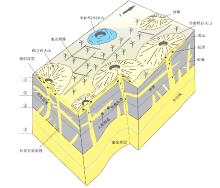 | 图 13 松原M5.7级地震液化构造模式图(据Collinson, 2006; 修改)Fig.13 Model of liquefied structures induced by the M5.7 earthquake in Songyuan area(modified after Collinson, 2006) |
自2006年以来, 松原地区进入地震活跃期, 尤其是2013年松原前郭地区M5.8级震群发育, 说明该区构造活动进入活跃期。学者们认为近东西向挤压应力场诱发的NE向和NW向断裂活动为震源(陈作全等, 2015; 李君和王勤彩, 2018), 然而学者们对于该地区发震断层意见不一(图 1-b), 如通榆— 长春断裂(薛艳等, 2015)、第二松花江断层(杨清福等, 2010)、孤店隐伏断裂(邵博等, 2015)、扶余/松原— 肇东断裂(王亮等, 2015; 刘权锋等, 2017), 查干花— 道字井断裂(盘晓东等, 2018), 也有学者认为是油田生产活动诱发(刘俊清等, 2017)。
2018年5月松原M5.7级地震后, 发现震中牙木吐村附近产生了1条新的正断层, 文中称之为牙木吐断裂(图 5)。如图 14所示, 该断裂走向NE35° , 断裂带宽度1.5~2.8 m, 断距10~30 cm。牙木吐同震断层具有典型双断地堑结构, 是地震应力释放至地表的反映(Ma et al., 2009; 田洪水等, 2015)。
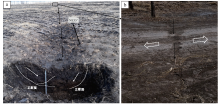 | 图 14 中国吉林松原M5.7级地震后形成的牙木吐断裂 a— 牙木吐断裂, 为双断式地堑结构, 照片拍摄位置为图 5中点A; b— 牙木吐断裂局部形态, 错断马路, 照片拍摄位置为图 5中点HFig.14 Yamutu fault formed after the M5.7 earthquake in Songyuan area, Jilin Province, China |
地震区周围广泛发育张裂缝, 尤其在牙木吐断裂周边, 裂缝尺寸和发育密度增大(图 15)。裂缝可分为2种类型:一种为共轭节理, 成对出现, 为追踪张节理, 2组节理走向分别为0° ~180° 和80° ~260° (图 15-a); 另外一种为0° ~180° 方向占绝对优势的张裂缝, 分布稳定, 单条裂缝延伸可超过50 m, 裂缝宽度0~4 cm, 裂缝密度1条/m。绝大多数裂缝没有被充填, 偶见个别裂缝充填砂(图 15-b)。
结合区域地质资料和研究成果, 根据地震后地面断裂和节理的类型和方向, 初步判定松原2018年5月M5.7级地震区域应力场特征为区域最大主压应力方向为40° ~220° , 最小主拉应力方向为130° ~310° (图 15-c)。牙木吐断裂延伸方向与扶余/松原— 肇东断裂方向基本一致(图 1-b), 推测扶余/松原— 肇东断裂为本次地震的发震断层。
松嫩平原第二松花江流经松原, 距离M5.7级地震震中距离不足500 m, 平均水位线129.32~134.95 m(田辉等, 2011), 牙木吐村周边海拔高度128~137 m, 5月下旬该区土地冰冻消融, 地震区地下水位较浅, 推测为2~5 m。地震活动产生的循环剪切力在该深度大于初始液化剪切力(详见Obermeier, 1996; Fig.3), 因此极易诱发地震液化(Owen and Moretti, 2011; 赵栖远, 2012)。
地震诱发液化砂火山的另一个重要条件是上覆非渗透层厚度不宜过大, 如果太厚会增加上覆载荷压力和抗剪强度, 因而无法液化, 容易导致液化封盖层厚度1~5 m。松原地区地表黏土厚度1.35~1.5 m, 具有液化发生的有利封闭层条件。也有学者报道液化产生的封盖层厚度超过10 m(Obermeier and Pond, 1999; Chan et al., 2007; Wheatley et al., 2016)
足够大的砂层厚度是液化前提, 松原地区黏土层下未固结干净砂层厚度超过20 m(图 3中地层单元⑤)。按照中国地震烈度表(1980), 松原M5.7级地震烈度为Ⅶ 级, 依据Ishihara(1985)研究方法(Obermeier and Dickenson, 2000), 松原地震地表加速度为0.17 g, 得出松原M5.7级地震液化砂层厚度约为2 m。
地表液化范围受控于震级和震源深度, 依据不同学者给出的最大液化震中距与震级相关关系公式或图版, 松原M5.7级地震最大液化半径2.878 km(Kuribayashi and Tatsuoka, 1975), 或2~10 km(Obermeier and Pond, 1999)、4~13 km(Tuttle, 2001; Bonini, 2009)。通过野外考察, 发现松原地震地表可见最大液化半径3 km, 与上述研究结果基本吻合。
松原M5.7级地震液化构造提供了研究现代地震的一个很好例子。作为重要的一种软沉积物变形构造, 液化变形构造可产生于多种沉积环境, 由多种机制触发(Moretti, 2016; Shanmugam, 2017), 地震成因液化构造的识别是研究热门也是难点, 许多学者给出相关判别标准(Obermeier, 1996; Tuttle, 2001; Moretti and Sabato, 2007; Owen and Moretti, 2011)。本研究为这些标准提供证据, 尤其是为研究古地震和古液化构造提供三维空间参数(Tuttle, 2001), 弥补了实验模拟的缺陷(Nichols et al., 1994; Owen, 1996; Moretti et al., 1999; Ross et al., 2011; Tian et al., 2013)。液化构造也是恢复地震等级的重要参数, 因此具有重要的“ 将今论古” 价值。
松原是地震活跃带, 频发的地震给当地农业和油田开发带来了严重灾害, 地震液化构造研究能够预测灾害易发区和影响范围, 因而能够指导当地工农业生产、建筑施工和油田勘探和生产动态监测。
松原地处松辽盆地腹地, 频发的地震表明周边构造运动活跃, 该研究有助于认识区域构造应力场及断层活动规律, 为盆地的演化乃至板块的活动研究提供基础数据, 具有“ 将今论未来” 价值。
陈颙(2000)认为, 关于郯庐断裂带这类活动深断裂— 地震带与其附近100~200 km的活动陆块边缘与强震区, 共同构成活动构造带, 而且郯庐断裂带邻近地区所发生的强地震一般与郯庐断裂带的活动有关。松原地区处在郯庐断裂带北段近旁。因此, 结合松原地区2006年以来发生的若干次地震, 本研究为揭示了郯庐断裂带目前的活动特点— — 本世纪以来郯庐断裂带北段进入了一个强断裂和地震活跃阶段, 提供最新的翔实资料。
1)松原M5.7级地震诱发大量的液化变形构造, 最常见的是砂火山构造, 包括有火山口型砂火山、无火山口型砂火山和无砂型(水)火山3类, 其次是砂堆构造、液化砂脉和砂席等。其他地震成因的变形构造如负载构造、火焰构造、包卷层理等也有发育, 数量较少。
2)地震诱发液化砂火山形成过程包括液化层内超孔隙流体压力形成、上覆低渗透层破裂和水、砂喷出地表后砂涌3个阶段。松原M5.7级地震液化构造可以分为最底部地震液化层、下部液化构造带、上部液化构造带和地表液化构造层4个序列。液化砂火山分布具有分带性, 主要延伸方向N-S, 其次为NW-SE, 地下液化构造主要为砂脉、砂席和其他液化变形构造。
3)地下水位线2~5 m, 上覆低渗透黏土层厚1.35~1.5 m, 松散砂层厚度超过20 m, 是松原M5.7级地震诱发广泛液化的有利条件。地震液化砂层厚度超过2 m, 地表震中距3 km范围内可见液化砂火山构造。
4)松原M5.7级地震后地表发育NE34° 地堑式正断层, 结合广泛分布的0° ~180° 向张裂缝和2组追踪张裂缝(0° ~180° 与80° ~260° )判断松原地震区最大主压应力方向为40° ~220° , 最小主拉应力方向为130° ~310° , 扶余/松原— 肇东断裂很可能是发震断层。
5)松原M5.7级地震液化构造研究为古代地震和液化构造研究提供三维空间参数, 为预测现代地震活动区和灾害易发区提供方向, 为区域构造研究提供基础, 兼具“ 将今论古” 和“ 将近论未来” 意义, 并对揭示21世纪以来郯庐断裂带北段进入了一个强断裂和地震活跃阶段有着重要意义。
致谢 感谢吉林油田王洋工程师、陈伟工程师和彭东昊工程师提供野外考察帮助; 感谢Monash University的Lü Wang博士和University of Aberdeen的Gail Maxwell 博士提供的沉积学方面的宝贵建议; 感谢东北石油大学平贵东博士、谢昭涵博士, 我们进行了关于区域构造应力场许多讨论。感谢3位匿名审稿人对初稿的修改建议。
(责任编辑 李新坡; 英文审校 龚承林)
| [1] |
|
| [2] |
|
| [3] |
|
| [4] |
|
| [5] |
|
| [6] |
|
| [7] |
|
| [8] |
|
| [9] |
|
| [10] |
|
| [11] |
|
| [12] |
|
| [13] |
|
| [14] |
|
| [15] |
|
| [16] |
|
| [17] |
|
| [18] |
|
| [19] |
|
| [20] |
|
| [21] |
|
| [22] |
|
| [23] |
|
| [24] |
|
| [25] |
|
| [26] |
|
| [27] |
|
| [28] |
|
| [29] |
|
| [30] |
|
| [31] |
|
| [32] |
|
| [33] |
|
| [34] |
|
| [35] |
|
| [36] |
|
| [37] |
|
| [38] |
|
| [39] |
|
| [40] |
|
| [41] |
|
| [42] |
|
| [43] |
|
| [44] |
|
| [45] |
|
| [46] |
|
| [47] |
|
| [48] |
|
| [49] |
|
| [50] |
|
| [51] |
|
| [52] |
|
| [53] |
|
| [54] |
|
| [55] |
|
| [56] |
|
| [57] |
|
| [58] |
|
| [59] |
|
| [60] |
|
| [61] |
|
| [62] |
|
| [63] |
|
| [64] |
|
| [65] |
|
| [66] |
|
| [67] |
|
| [68] |
|
| [69] |
|
| [70] |
|
| [71] |
|
| [72] |
|
| [73] |
|
| [74] |
|
| [75] |
|
| [76] |
|
| [77] |
|
| [78] |
|
| [79] |
|
| [80] |
|
| [81] |
|
| [82] |
|
| [83] |
|
| [84] |
|
| [85] |
|
| [86] |
|
| [87] |
|
| [88] |
|
| [89] |
|
| [90] |
|
| [91] |
|
| [92] |
|
| [93] |
|
| [94] |
|
| [95] |
|
| [96] |
|
| [97] |
|
| [98] |
|
| [99] |
|
| [100] |
|
| [101] |
|
| [102] |
|
| [103] |
|
| [104] |
|
| [105] |
|
| [106] |
|
| [107] |
|
| [108] |
|
| [109] |
|
| [110] |
|
| [111] |
|
| [112] |
|
| [113] |
|
| [114] |
|
| [115] |
|
| [116] |
|
| [117] |
|
| [118] |
|
| [119] |
|
| [120] |
|
| [121] |
|
| [122] |
|
| [123] |
|
| [124] |
|
| [125] |
|
| [126] |
|
| [127] |
|
| [128] |
|
| [129] |
|
| [130] |
|
| [131] |
|
| [132] |
|
| [133] |
|






